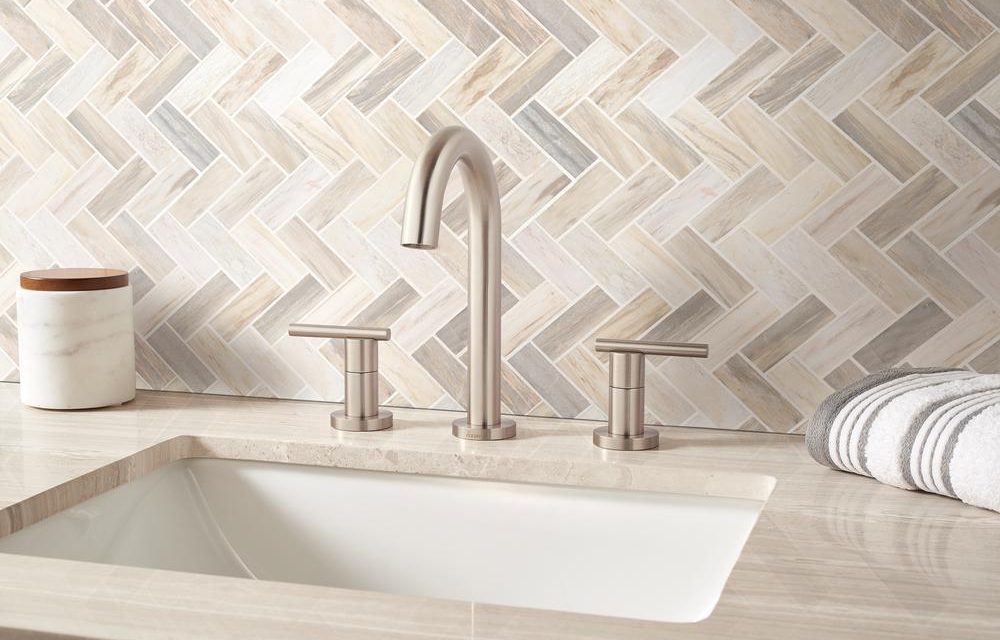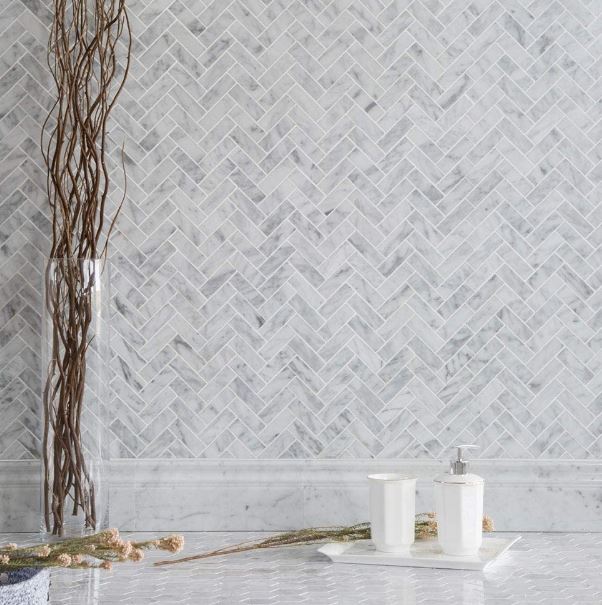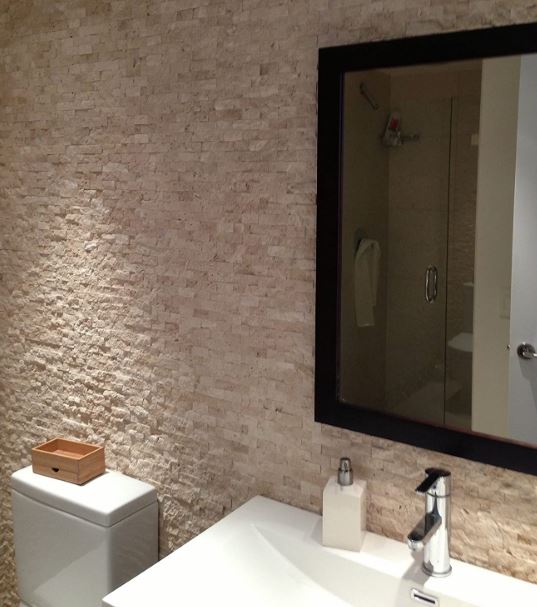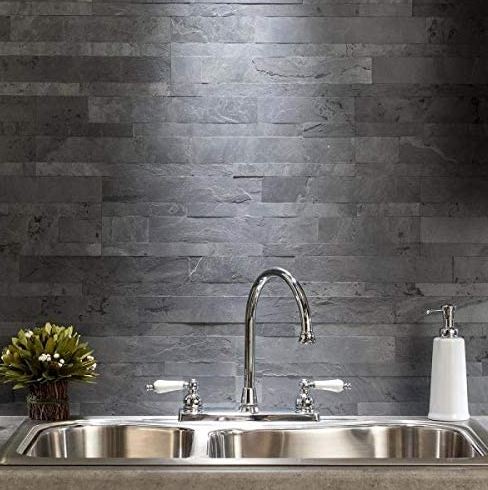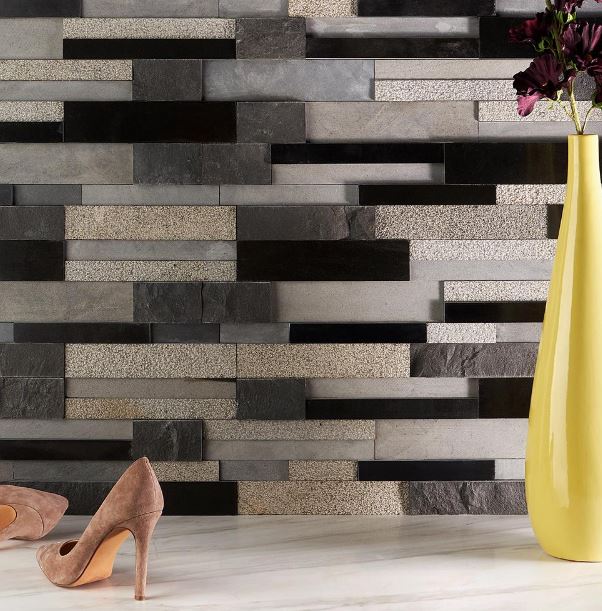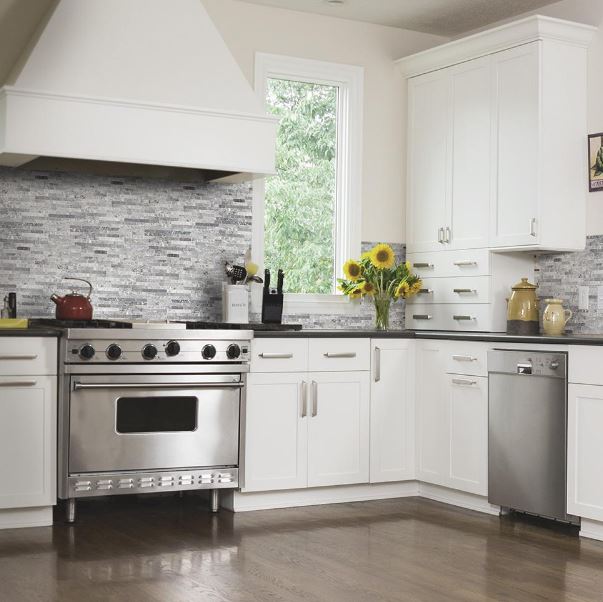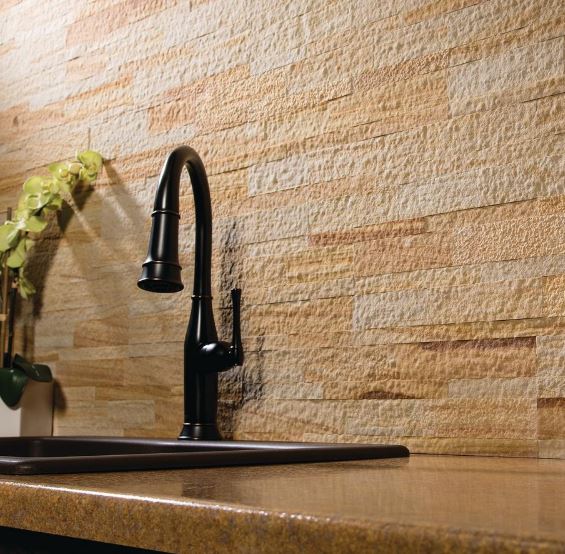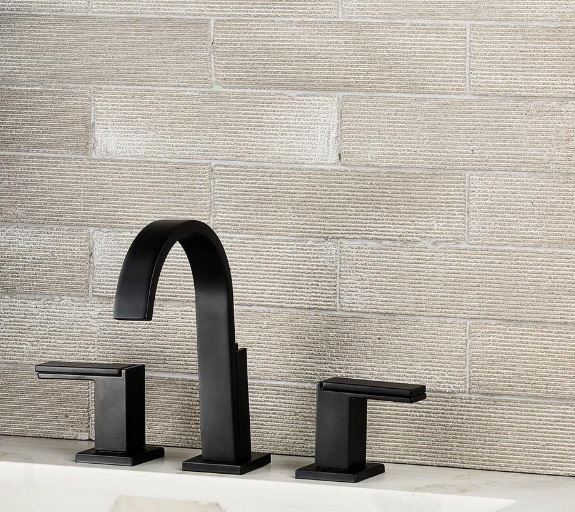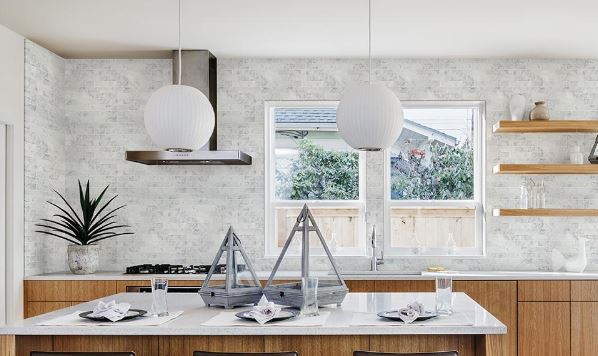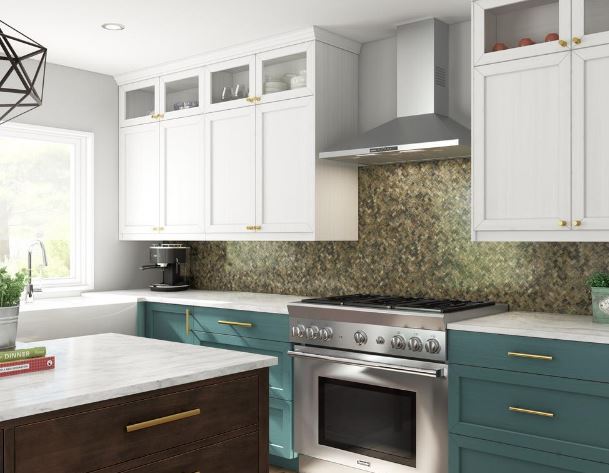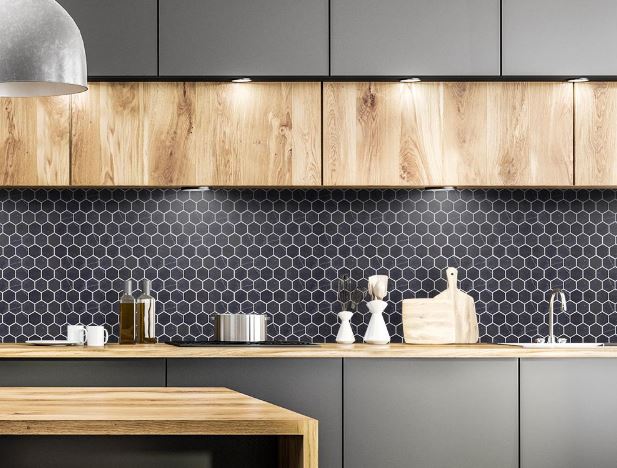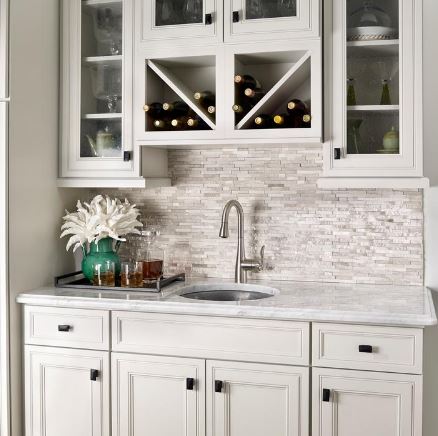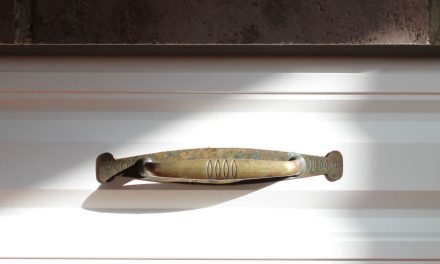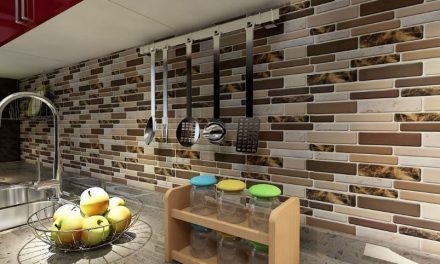Stone is a classic material that can be used to accent many surfaces in the home. From ancient times, people have covered their walls and floors with stone. Today, it remains popular in the same places, as well as for backsplashes in the kitchen and bathroom.
A wide variety of stone options are available for your consideration, but not all stone is alike. In this article, we’ll break down some common types of stone used in home surfacing as well as the different finishes that can be applied to them. With the right stone (and the right finish) you can get just the look you want in your kitchen, bathroom, or anywhere else in your house.
Types of stone backsplashes
You might wonder what types of stone has to do with types of finish, but these two aspects are closely related. Different types of stone take best to different finishes. And certain finishes are much more popular with certain kinds of stone.
Marble and onyx
Marble has historically been a very popular material for counters and backsplashes. Its distinctive patterns are prized for the classic, sophisticated look they bring to a kitchen. Onyx is less popular, but it, too, has distinctive patterns and can bring a modern aesthetic to your home. Still, these stones aren’t without their problems.
First and foremost (and maybe despite appearances), marble and onyx are relatively porous. This means they require regular sealing to prevent stains and water damage. More problematically, marble (and many kinds of onyx) contains calcite, which can etch in the presence of acids. This means orange juice and tomato sauce splatters can leave marks in your backsplash if not cleaned right away. Worst of all, sealing does not prevent this from happening.
Marble and onyx are also relatively soft compared to other common stone backsplash materials, so they may scratch if not treated carefully. All that said, as long as you’re willing to give your marble or onyx backsplash a little extra care, it will stay beautiful and functional for a long time.
Travertine and limestones
Travertine and other limestones are popular materials for kitchen backsplashes. Depending on finish and style, they can grant a kitchen an old-world charm or provide a neutral, elegant basis for a more contemporary design. Travertine is available in colors ranging from cream to beige to gold to brown. Other limestones can be available in a variety of shades, though most will have a similar, variegated pattern.
These kinds of stone are especially susceptible to staining from acidic substances, like orange juice or tomato sauce. While regular sealing can prevent most staining, acid can still etch them. This causes discoloration and gouges in the finish.
Travertine and limestone have a medium porosity, so sealing is important, but water damage is relatively unlikely, if maintained properly. Like, marble and onyx, travertine and limestone are relatively soft, so they may scratch if care is not taken.
Slate
Slate is a great option for a kitchen backsplash. It’s relatively scratch and crack resistant, and it’s available in several colors, though most slate available will be some shade of gray. That can come with a downside: its generally darker tone may make water marks show up more clearly.
Slate’s porosity is highly dependent on where the slate comes from, so its stain resistance is variable. The densest, and least porous, slate is quarried from sites in Canada and Wales. This slate is generally higher in quality and its price may be commensurately higher.
Darker slate gives a sleek, modern look to a kitchen, while lighter varieties can look rustic and homey. Slate is prized for its durability, and this stone is likely to last for years to come, provided you give it regular care.
Granite and Basalt
If you’re especially concerned about etching from acidic substances, granite and basalt are a good bet. They’re volcanic stones, and their lack of calcite makes them much less susceptible to erosion than marble, onyx, and limestones. Keep in mind, though, that granite can etch badly when exposed to hydrofluoric acid, so check any harsher cleaners you want to use for this acid. Granite is also denser than marble and less porous, meaning stains and water damage are unlikely. Basalt is even denser, though it can be porous, so sealing is recommended.
A granite backsplash is a classic option that brings a sense of timeless sophistication to a kitchen. It’s especially effective paired with matching granite countertops, though keep in mind that the patterns of granite can come off as a little busy, especially with a full-height backsplash.
Granite is available in a wide range of colors, from tan to blue to brown to black, though white granite is one of the most popular (and most expensive) for the home kitchen. Basalt tends to be more neutral in color, making it a great option paired with busier patterns. Both of these types of stone are, however, incredibly durable, making them less likely to scratch or chip. These materials are great, rugged options that will keep their looks with minimal maintenance.
Bluestone and sandstones
Bluestone can be a complicated term, and it refers to different types of stone in different places, so be sure to check exactly what kind of material a bluestone tile is made of before buying it. In the US, bluestone tiles are usually a type of hard, durable sandstone. But look out for Shenandoah bluestone—this is actually a type of limestone that has more in common with travertine.
The main difference between bluestone and other sandstones is the color. Bluestone is not always blue, but it generally has a blue tone. It can be gray, dark gray, and even lilac in color. Common sandstone colors include white, beige, brown, and red. These types of stone are harder than marble and more resistant to scratching and gouging.
Quartzite is an excellent option for kitchen backsplash whose popularity is on the rise. It is stain resistant, and scratch resistant, so maintenance is kept at a minimum, though it still requires occasional sealing. Quartzite is a metamorphic stone that began life as sandstone, and it shares its durability. And, much like sandstone, acidic stains aren’t a problem. Though, like, granite, hydrofluoric acid definitely is.
Quartzite is available in a wide variety of colors, reflecting the shades of not only the sand that quartzite began as, but the various other minerals it may have come into contact with while forming. Though most quartzite on the market is white or pale gray. Its pattern, too, can vary somewhat, so make sure to keep that in mind before purchasing.
‘Soft quartzite’ is another option for natural stone kitchen backsplash that may look very similar to real quartzite, but it’s actually much more similar to marble and onyx. It will scratch and stain more easily, and is not especially durable. If in doubt, ask the manufacturer if something is real quartzite.
Another similar term that refers to a very different material is quartz. A quartz countertop or backsplash is actually a type of manufactured stone, which has some similar properties to quartzite, but is not natural.
Clay tile
Many sites and stores offer a ‘clay’ style of stone tile. These are much more likely than other types of stone to be described as glossy or high-gloss. But don’t be fooled by the different terms used—these are just ceramic or porcelain tiles. They can be glazed or unglazed, but, regardless, their finishes will have much more in common with ceramics than stone.
Types of stone backsplash finishes
Several types of finishes exist for stone, with some more suited to certain types of stone than others. On the glossy-looking end, you have polished and satin finishes. On the more matte end, you have honed and textured finish options.
Polished
Polished finishes have the highest shine of any stone finish. This stone undergoes significant smoothing with a series of polishing wheels that grant a smooth, reflective surface. Polished finishes are also referred to as high-gloss or glossy, and this type of finish ensures that even the smallest detail of the stone you choose will be visible. Unfortunately, this visibility also means that even minor scratches are easy to see.
The smooth surface of a polished finish, however, means that clean-up is a breeze. This finish also makes the stone less porous, so polished stone requires less resealing. Polished stone tile can grant an elegant, traditional look to more formal spaces. This finish is particularly popular with marble, though other kinds of stone can also benefit from its high sheen and light-reflecting qualities.
Satin
A satin finish lies somewhere between a polished and honed look. Polishing wheels are used to make the surface smooth, but fewer than are used for a polished finish. This finish is also sometimes referred to as semi-gloss. This finish can be less popular at big box home improvement stores, but it’s often preferred by many small-time retailers and manufacturers.
A satin finish is a good compromise between the high gloss of polished finishes and the matte appearance of honed stone. It still reflects light, making your kitchen seem larger and brighter, but it also hides minor scratches better than polished stone. Its rougher texture can be a little harder to clean than the smooth surface of polished finishes, and it makes the stone more porous, meaning stains and water damage are more likely.
Honed
A honed finish undergoes less smoothing than a polished or satin finish and retains more of the texture and character of the original stone. It provides a matte, more muted appearance that can complement higher contrast elements or impart a more rustic feel on your kitchen. In fact, honed finish stone is also sometimes referred to as a matte finish, so be sure to check both terms when looking for this type of stone finish.
Honed stone is more porous than polished stone, so you’ll need to refinish it more often to prevent water damage and stains. Its more textured surface can also make it harder to clean, and it will collect dust more readily. However, its matte look hides minor scratches much better than higher gloss finishes.
The harder the stone, the harder polishing it is. Because of this, some harder, more durable materials, like sandstone, take best to a honed finish. But even some softer stones, like travertine, take well to a warm, muted look.
Textured
Textured looks are great if you want a finish that will last a long time without requiring substantial maintenance. Their uneven surfaces easily hide scratches and smaller gouges easily, doing little more than adding additional character to the stone. However, textured finishes are generally harder to clean and collect more dust and grime. A textured finish leaves you with a much more porous surface than a polished or even a satin finish.
There are dozens of textured finishes available, though many aren’t especially common. The most popular are tumbled (which softens both edges and colors) and brushed (created by brushing the stone with a steel comb). These grant a rustic, natural look to a kitchen while keeping their surfaces relatively easy to clean.
A natural finish is barely a finish at all. Instead, this stone retains all the character and complication of totally natural stone. After it’s quarried, little else is done to it before you acquire it. This finish provides a rough, rugged feel and is especially popular with slate.
Filled vs. unfilled
Some types of natural stone tile (especially travertine) can be purchased as either filled or unfilled. A filled tile has had its natural crags and indentations filled in with resin, often a polyester resin. This prevents dust from collecting in the holes and provides a smoother surface for finishing.
Some people swear by unfilled travertine, however. It allows the stone to retain a more rustic, natural look. Some tile installers (and DIYers) even fill in the holes of unfilled stone with grout, giving a mottled appearance that can hide the grout lines between tiles. This makes the backsplash feel more cohesive.
To fill or to not fill is a personal choice, but if you’re looking for easy maintenance and install, it’s better to go with filled.
DIY stone backsplash installation
Most stone backsplash installations should be left to the professionals, but if you’re particularly handy in your home and have access to a tile saw, some types of stone tiles can make for a great project.
Check out the video below to learn how to install a common ledger stone backsplash.

